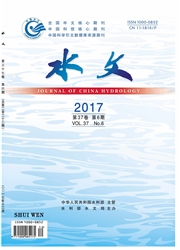

 中文摘要:
中文摘要:
ASD(AutomatedStatisticalDownscaling)是一种基于回归分析的统计降尺度方法。应用ASD方法.选取东部季风区3个典型流域地面观测资料、ERA-40再分析资料,建立预报量与大气环流因子之间的统计关系.对日降水量和日平均、最高、最低气温进行模拟,并评价模型对不同流域不同变量的模拟效果。分析其适用性。结果表明,ASD模型能较好模拟出各地面变量的时间序列演变规律及空间分布特征。对气温变量的模拟效果优于降水变量。模型对水文气象特征各异的三个流域模拟效果均较好,同时有所差异,这与各流域不同的地理、气象因素有关。以上结果说明,ASD模型在东部季风区适用性较好.可应用于构建未来气候变化情景及为水文模拟提供输入资料等相关方面。
 英文摘要:
英文摘要:
Statistical downscaling methods are usually used to fill the gap between large-scale climate change data and fine-scale hydrological application. Automated Statistical Downscaling (ASD) technique was investigated with the combination of a case study in 3 typical basins of eastern monsoon region in China in this paper. Statistical relationship between the predictant and predictor was developed by using the observed data of the 3 river basins and ERA-40 reanalysis data, and the high resolution daily precipitation, daily air temperature, daily maximum temperature and daily minimum temperature were then generated. Finally, the performance and suitability of ASD model were evaluated. The results show that ASD is capable of simulating temporal and spatial change characteristics of data seties. Furthermore, the efficiency of simulation on air temperature variables is better than precipitation, and the performance of this model changes in different basins, as depending on geographic and meteorological factors of the study area. In a word, ASD model performs effectively in the study areas, which can be used to generate future scenarios in the related studies.
 同期刊论文项目
同期刊论文项目
 同项目期刊论文
同项目期刊论文
 期刊信息
期刊信息
